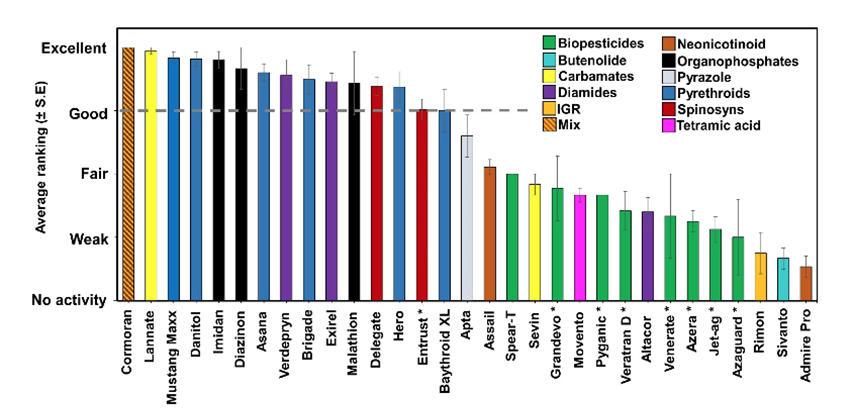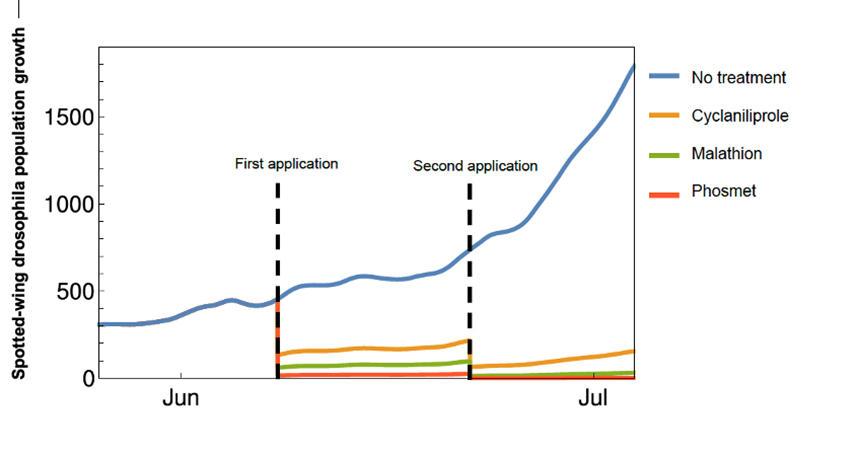Spotted-wing drosophila (Drosophila suzukii) is a pest in soft-skinned fruit production, including blueberry, cherry, blackberry and raspberry. It is a major concern in fruit production worldwide. Insecticide applications remain the most common control strategy against SWD.
Researchers and stakeholders from California, Oregon, Washington, Michigan, Maine, New York, New Jersey, North Carolina, Georgia and Florida have ranked the efficacy of the most-used insecticides to control SWD populations in the field. Insecticides vary in their modes of action, and their efficiency against SWD can vary greatly. To date, insecticide research has focused primarily on adult mortality. Here we consider insecticidal action against immature and adult life stages of SWD, resistance management and sequential order of insecticide sprays. These factors are important when considering efficacy and sustainability in a whole-system approach.
Products are ranked by relative insecticidal efficacy based on laboratory and field experiments in multiple locations across the United States. Products are color-coded based on their modes of action. This relative ranking provides insights into priority chemical control strategies and provides optimal resistance management of SWD. (Figure 1).
Whole-population control
While we tend to think about controlling adult flies, most of the population in the field is in the immature stages, including eggs, larvae and pupae. There are few reports of insecticide effects on these immature life stages. For effective control, we must consider all life stages when planning a spray program. Table 1 shows the percent mortality of all life stages from various pesticides. While unripe fruit may be at reduced risk of infestation, early season control is important to reduce the population seasonlong (Figure 2). Reducing all life stages early in the season can significantly inhibit population growth and reduce the number of SWD adults to be controlled some weeks later. Phosmet efficacy ranked highest in this study (Table 1) and provides excellent management of immature life stages. If applied early in the season, phosmet can reduce immature life stages and the adult SWD population. Growers who detect SWD eggs and larvae in their crop should consider using products ranked “high” in Table 1 as their first spray. Growers should pay extra attention to label restrictions and the maximum number of applications permitted during the season. As the crop nears harvest, growers should apply products with lower relative mortality and a shorter preharvest interval (PHI) to ensure that their crop can be delivered to market.
| Insecticide (Active ingredient) |
Percent mortality | Relative mortality ranking | Average mortality of all stages | PHI* (day) | |||
|---|---|---|---|---|---|---|---|
| Egg | Larvae | Pupa | Adult | ||||
| Imidan 70 WP (phosmet) |
91 | 92 | >99 | 99 | High | 95 | 3 |
| Lannate (methomyl) |
84 | 77 | 100 | 99 | High | 90 | 3 |
| Delegate (spinetoram) |
84 | 81 | 99 | 95 | High | 89 | 3 |
| Entrust (spinosad) |
83 | 76 | >99 | 95 | High | 88 | 3 |
| Malathion 8F (malathion) |
85 | 72 | 98 | 90 | Medium | 86 | 1 |
| Assail (acetamiprid) |
80 | 78 | 90 | 90 | Medium | 84 | 1 |
| Exirel (cyantraniliprole) |
73 | 69 | 95 | 95 | Medium | 83 | 3 |
| Danitol 2.4 (fenpropathrin) |
63 | 67 | 95 | 95 | Medium | 80 | 3 |
| Mustang Maxx (zeta-cypermethrin) |
52 | 60 | 99 | >99 | Medium | 77 | 1 |
| Harvanta 50 SL (cyclaniliprole) |
67 | 71 | 70 | 70 | Low | 69 | 1 |
*Preharvest interval
Slow the development of resistance
Insecticidal resistance starts to develop with the first product application. Managing insecticidal resistance is essential to maintain effective SWD control and to protect the efficacy of the chemical tools currently available. Researchers have documented SWD resistance in the U.S. to key insecticides, including spinosad (spinosyn).
Rotating chemical classes with different modes of action during the season delays development of insecticide resistance. The Insecticide Resistance Action Committee (IRAC) classification of chemical classes allows producers to design a seasonal control program according to insecticide mode of action. Products approved for SWD are presented in Figure 1, color-coded by insecticidal class. Growers are advised to use spinosad sparingly in the early season, allowing for its use closer to harvest, due to its short preharvest interval. Use of a product such as Harvanta 50 SL (cyclaniliprole) may be of value as it falls in a different chemical class.
Keep resistance in mind as you plan your seasonlong chemical control of SWD.
Plan seasonal applications
SWD populations grow rapidly under ideal summer temperatures. Modeling and field trials indicate that an initial application of an insecticide most effective at killing all life stages (for example, phosmet) will significantly reduce the number of individuals compared to a less-effective insecticide (for example, malathion and cyclaniliprole) (Figure 2).
Different formulations of the same active ingredient may also perform differently. For example, researchers indicated that cyclaniliprole as Verdepryn provided good control in the field. By contrast, cyclaniliprole as Harvanta 50 SL provided low efficacy on SWD in a laboratory experiment. Controlled laboratory conditions typically generate stronger results than field conditions. Mixed formulations — products that combine more than one active ingredient in a single formulation — could improve control. For example, Cormoran combines acetamiprid and novaluron, and provided excellent control of SWD (Figure 1).
An integrated approach to SWD management offers the greatest chance of success. Integrating cultivar selection, cultural practices and an awareness of site-specific conditions and relative SWD pressure is essential for sustainable management of SWD. Cultural practices, such as weed fabric, pruning and drip irrigation, can also reduce SWD infestation. Use behavioral and biological control and other emerging management tools when available and applicable. Finally, begin the season with an insecticide plan to minimize the development of insecticidal resistance.
Useful links
The Insecticide Resistance Action Committee. The IRAC mode of action classification online.
References
Mermer, S., F. Pfab, G. Tait, R. Isaacs, P. D. Fanning, S. Van Timmeren, G. M. Loeb, S. P. Hesler, A. A. Sial, J. H. Hunter, H. K. Bal, F. Drummond, E. Ballman, J. Collins, L. Xue, D. Jiang, and V. M. Walton. 2021. Timing and order of different insecticide classes drive control of Drosophila suzukii; a modeling approach. J Pest Sci 94: 743-755.
¡Use los pesticidas con seguridad!
- Póngase ropa de protección y equipo de seguridad según las recomendaciones de la etiqueta. Báñese después de cada uso.
- Lea la etiqueta del pesticida—aunque lo haya usado antes. Siga al pie de la letra las indicaciones de la etiqueta (y cualquiera otra indicación que Ud. tenga).
- Tenga precaución al aplicar los pesticidas. Conozca su responsabilidad legal como aplicador de pesticidas. Usted puede ser responsable de heridas o daños resultantes del uso de un pesticida.








